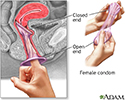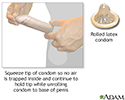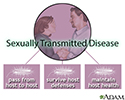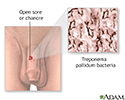Safe sex
Chlamydia - safe sex; STD - safe sex; STI - safe sex; Sexually transmitted - safe sex; GC - safe sex; Gonorrhea - safe sex; Herpes - safe sex; HIV - safe sex; Condoms - safe sex
Safe sex means taking steps before and during sex that can prevent you from getting an infection, or from giving an infection to your partner.
Information
A sexually transmitted infection (STI) is an infection that can be spread to another person through sexual contact. STIs include:
- Chlamydia
- Genital herpes
- Genital warts
- Gonorrhea
- Hepatitis
- HIV
- HPV (human papilloma virus)
- Syphilis
STIs are also called sexually transmitted diseases (STDs).
These infections are spread by direct contact with a sore on the genitals or mouth, body fluids, or sometimes the skin around the genital area.
Before having sex:
- Get to know your partner and discuss your sexual histories.
- Don't feel forced into having sex.
- Don't have sexual contact with anyone but your partner.
Your sexual partner should be someone who you know does not have any STI. Before having sex with a new partner, each of you should get screened for STIs and share the test results with each other.
If you know you have an STI such as HIV or herpes, let any sexual partner know this before you have sex. Allow him or her to decide what to do. If you both agree to have sexual contact, use latex or polyurethane condoms.
Use condoms for all vaginal, anal, and oral intercourse.
- The condom should be in place from the beginning to the end of the sexual activity. Use it every time you have sex.
- Keep in mind that STIs can be spread by contact with skin areas around the genitals. A condom reduces but does not eliminate your risk of getting an STI.
Other tips include:
- Use lubricants. They may help reduce the chance that a condom will break.
- Use only water-based lubricants. Oil-based or petroleum-type lubricants can cause latex to weaken and tear.
- Polyurethane condoms are less likely to break than latex condoms, but they cost more.
- Using condoms with nonoxynol-9 (a spermicide) may increase the chance of HIV transmission.
- Stay sober. Alcohol and drugs impair your judgment. When you are not sober, you might not choose your partner as carefully. You may also forget to use condoms, or use them incorrectly.
Get tested regularly for STIs if you have new sexual partners. Most STIs have no symptoms, so you need to be tested often if there is any chance you have been exposed. You will have the best outcome and will be less likely to spread the infection if you are diagnosed early.
Consider getting the HPV vaccine to keep from getting the human papillomavirus. This virus can put you at risk for genital warts and for cervical cancer in women.
References
Del Rio C, Cohen MS. Prevention of human immunodeficiency virus infection. In: Goldman L, Schafer AI, eds. Goldman-Cecil Medicine. 26th ed. Philadelphia, PA: Elsevier; 2020:chap 363.
Eckert LO, Lentz GM. Genital tract infections: vulva, vagina, cervix, toxic shock syndrome, endometritis, and salpingitis. In: Gershenson DM, Lentz GM, Valea FA, Lobo RA, eds. Comprehensive Gynecology. 8th ed. Philadelphia, PA: Elsevier; 2022:chap 23.
Swygard H, Cohen MS. Approach to the patient with a sexually transmitted infection. In: Goldman L, Schafer AI, eds. Goldman-Cecil Medicine. 26th ed. Philadelphia, PA: Elsevier; 2020:chap 269.
US Preventive Services Task Force; Krist AH, Davidson KW, et al. Behavioral counseling interventions to prevent sexually transmitted infections: US Preventive Services Task Force Recommendation Statement. JAMA. 2020;324(7):674-681. PMID: 32809008 pubmed.ncbi.nlm.nih.gov/32809008/.
Workowski KA, Bachmann LH, Chan PA, et al. Sexually transmitted infections treatment guidelines, 2021. MMWR Recomm Rep. 2021;70(4):1-187. PMID: 34292926 pubmed.ncbi.nlm.nih.gov/34292926/.
The female condom - illustration
The female condom
illustration
The male condom - illustration
The male condom
illustration
STDs and ecological niches - illustration
STDs and ecological niches
illustration
Primary syphilis - illustration
Primary syphilis
illustration
Review Date: 5/12/2022
Reviewed By: Linda J. Vorvick, MD, Clinical Associate Professor, Department of Family Medicine, UW Medicine, School of Medicine, University of Washington, Seattle, WA. Also reviewed by David C. Dugdale, MD, Medical Director, Brenda Conaway, Editorial Director, and the A.D.A.M. Editorial team.











